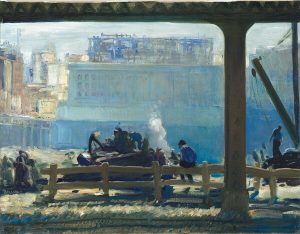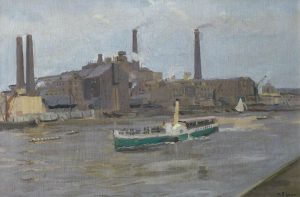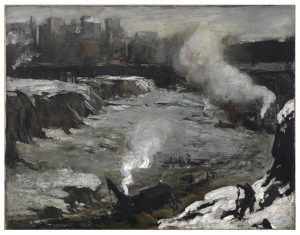This slide show is a record of a mid-semester assignment: all students were asked to prepare multiple comparisons between an Ashcan and a Camden Town Group painting to share with the class.
ComparisonsAshcan_Camden Town List of Works
| Artist | Title | Date | Size | Medium | Collection | Museum Accession No. | Chosen By | Notes |
|---|---|---|---|---|---|---|---|---|
| Henri | Coal Breaker | 1902 | o/c | BCMA | Sydney | |||
| Glackens | Italo-American Celebration, Washington Sq. | 1912 | 65.4x81.28cm | o/c | MFA Boston | Sabrina | ||
| Shinn | Spanish Music Hall | 1902 | 35x45cm | o/c | MMA | Emily | ||
| Luks | Subway | 1897 | 28x35cm | pastel | Johnson Museum, Cornell University | Elisha | ||
| Luks | Knitting for the Soldiers | 1918 | 767x918mm | o/c | Terra Foundation | 1999.87 | Holly | |
| Luks | Noontime, St Botolphs St, Boston | 1923 | MFA Boston | Harrison | ||||
| Luks | Madison Sq. Garden Prize Fight | 61 x 81 cm | o/c | Ringling Museum, Sarasota | Ramiro | |||
| Sickert | Girl at a Looking-Glass, Little Rachel | 1907 | 511x410mm | o/c | Fitzwilliam Museum, Cambridge | Sabrina | similar one at the Tate https://www.tate.org.uk/art/research-publications/camden-town-group/walter-richard-sickert-girl-at-a-window-little-rachel-r1136821 | |
| Sickert | The Milkman | 1907 - 1914 | 85.2 x 54.6 cm | o/c | University of Aberdeen | ABDUA 30198 | Ramiro | |
| Sickert | Easter Monday-Hélène Daurmont | 1906 | Unframed: 50.8 x 40.7 cm (20 x 16 in.) | O/c | Cleveland Museum of Art | Elisha | ||
| Sickert | Suspense | 1916 | H 76.5 x W 59 cm | o/c | Ulster Museum, Belfast, Ireland | BELUM.U490 | Holly | see also: drawing prep -- https://hvrd.art/o/12825 |
| Sickert | The Laundry Shop | 1885 | 38.7 x 24.7 cm | oil on wood | Leeds Art Gallery | LEEAG.PA.1937.0017 | Sydney | |
| Bellows | Return of the Uselss | 1918 | 149.9 × 167.6 cm | o/c | Crystal Bridges Museum of American Art | 2009.6 | Sabrina | |
| Bellows | Blue Morning | 1909 | 34 x 44 in | o/c | National Gallery of Art, Washington, D.C. | 1963.10.82 | Holly | see -- p. 114-116 of Wolner reading |
| Bellows | Shower Bath, First State | 1917 | Image: 16 x 23 3/4 in. (40.6 x 60.3 cm) | Lithograph, Print | MET | 1971.514.9 | ||
| Bellows | Pennsylvania Excavation | 1907 | 33 7/8 x 44 in | o/c | Smith College Museum of Art | SC 2010.11 | Sydney | |
| Bellows | The Murder of Edith Cavell | 1918 | 47x63 cm | Lithograph | 3 prints at Colby alone | 119.2013 | Emily | |
| Bellows | Love of Winter | 1914 | 86.1x101.6cm | o/c | Art Institute of Chicago | 1914.1018 | Ramiro | |
| Sloan | A Window on the Street | 1912 | 26 x 32 in | o/c | BCMA | 1961.5 | Holly | |
| Sloan | Blonde Nude | 1917 | 20 1/4 x 24 1/6 in | o/c | BCMA | 1961.53 | Elisha | |
| Sloan | Arch Conspirators | 1917 | 4 5/16 x 6 in | etching on paper | BCMA | 1961.69.30 | Sydney | |
| Ginner | Spring Day at Boscastle | 1943 | H 83.8 x W 53.3 cm | o/c | Arts Council Collection, Southbank Centre, London | AC 139 | Holly | see preparatory study -- http://www.artnet.com/artists/charles-ginner/spring-day-at-boscastle-study-UN7uwB1CxTqzDYe50rT1JQ2 |
| Gilman | Edwardian Interior | 1907 | 53.3. x 54 cm | o/c | Tate | T00096 | Sydney | |
| Gore | Inez and Taki | 1910 | 405 x 510 mm | o/c | Tate UK | N05859 | Elisha | |
| Ginner | From a Hampstead Window | 1923 | 443 x 314 mm | Ink, watercolour and graphite on paper | Tate | N03873 | Sabrina | |
| Sloan | Shine, Washington Square | 1923 | 8 3/8 in. x 9 5/8 in. (21.2 cm. x 24.5 cm.) | lithograph on paper | BCMA | 1961.69.2 | Sabrina | |
| Ginner | The Filling Factory | 1916 | 304.8 x 365.8 x 3.8 cm | o/c | National Gallery of Canada | 8173 | Sabrina | |
| Ginner | Rottingdean | 1914 | 64.8 x W 81.2 cm | o/c | Worthing Museum and Art Gallery | 1937 | Ramiro | |
| Ginner | London Bridge: Adelaide House and Fresh Wharf | 1913 | 76.2 x W 48.4 cm | o/c | Museum of London | 64.48 | Ramiro | |
| Gore | Tennis at Hertingfordbury | 1910 | 40.5 x 50.8 cm | o/c | Yale Center for British Art | B1980.32 | Ramiro | |
| Bellows | Tennis at Newport | 1919 | 101.6 × 109.9 cm | o/c | The MET | 67.187.121 | Ramiro | |
| Sloan | Signals | 1916 | 50.8 cm x 61.28 cm | o/c | BCMA | 1961.56 | Ramiro | |
| Gore | From a Canal Bridge, Chalk Farm Road | 1913 | H 43.3 x W 68.6 cm | o/c | York Art Gallery | YORAG : 1035 | Holly | |
| Glackens | At Mouquin’s | 1905 | 122.4 x 92.1 cm | o/c | Art Institute of Chicago | 1925.295 | Holly | |
| Sloan | Three A. M. | 1909 | 32 x 26 in | o/c | Philadelphia Museum of Art | 1946-10-01 00:00:00 | Holly | |
| Sickert | A Marengo | 1903-04-01 00:00:00 | H 38.1 x W 45.7 cm | o/c | Tate | N03621 | Holly | |
| Sloan | Their Appointed Rounds | 1938 | 5 1/2 in. x 7 in. (14 cm. x 17.8 cm.) | etching and mezzotint on paper | BCMA | 1961.69.98 | Sabrina | |
| Gore | North London Girl | 1911-12-01 00:00:00 | 762 × 610 mm | oil on canvas | Tate | T00027 | Sabrina | |
| Bellows | Paddy Flanagan | 1908 | 76.8 cm (30.2 in); Width: 63.5 cm (25 in) | oil on canvas | private collection | Sabrina | ||
| Gilman | Black Gardener | 1905 | 144 cm x 92cm | oil on canvas | Garden Museum, UK | Sabrina | https://gardenmuseum.org.uk/collection/portrait-of-a-black-gardener/ | |
| Bellows | Men of the Docks | 1912 | 114.3 × 161.3 cm | oil on canvas | National Gallery, UK | NG6649 | Sabrina | |
| Drummond | In the Park (St James’s Park) | 1911 | 725mm x 900mm | oil on canvas | Southampton City Art Gallery | SOTAG : 1427 | Sabrina |
- “Rectilinear Structure” and the Life of the Railroad in Bellows and Sickert. Comparison written by Holly Lyne. Both George Bellows and Walter Sickert capture the technological possibility of the modern city’s railroads in their respective paintings Blue Morning (Fig. 1) (1909) and Queen’s Road Station, Bayswater (Fig. 2) (1916). Though initially subtle, the visual parallels between the compositions of the two paintings prove quite stunning. However, the two paintings differ in their temporality and mood. Blue Morning shows the first strikes into a ground rife with possibility during the excavation of New York’s Pennsylvania Station, whereas Queen’s Road Station, Bayswater depicts one of London’s older tube stations in a muted, somber color palette and references the city’s ongoing involvement in World War I.

Figure 1. George Bellows, Blue Morning, 1909, oil on canvas, 34 x 44 in. National Gallery of Art, Washington, D.C., Chester Dale Collection. Image courtesy of National Gallery of Art, Washington.

Figure 2. Walter Sickert, Queens Road Station, Bayswater, 1916, oil on canvas, 24.5 x 28.7 in. The Courtauld, London, Roger Eliot Fry Collection. Image courtesy of Art UK.
2. “Merging Technologies” written by Sydney Reaper. In The Thames at Battersea and Pennsylvania Excavation (produced in the same year) we are brought to spaces of the city that open up to a landscape–either a preexisting waterway or constructed tunnel–in a wide frame that displays the wide range of technologies that propel the city. In Harold Gilman’s water scene, there are distinct visual pairings: the smokestacks of the steamship mirror the factory on the water’s edge; the white sail and wooden hull of the sailboat mirror the white shirts and boat of a rowing team. In George Bellow’s capturing of the construction of Pennsylvania Station, the artist sets up similar parallels. The train in the middle-ground reflects the colors and structure of other industrial forms such as a bridge and cityscape in the background, whereas a pair of workers in the foreground nearly blend into the exposed rock. In both works we see combinations of manpower and industrial machines, either working together or presented in juxtaposition to one another, as if technological advances of the city have not yet taken over as the most efficient means of production.

Figure 1. Harold Gilman, The Thames at Battersea, 1907, oil on canvas, 60 x 90.5 cm, Kirkcaldy Galleries.

Figure 2. George Bellows, Pennsylvania Excavation, 1907, oil on canvas, 33 7/8 x 44 in, Smith College Museum of Art.
